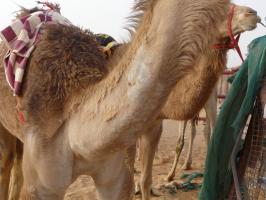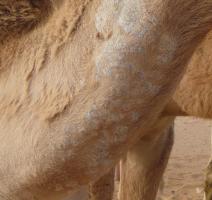Wounds and Abscesses
Wounds/Definition
The word "wound" is taken to mean any break in the skin or mucous membrane. The underlying tissue is frequently also involved. Wounds occur in all animals on every farm and arise from a variety of causes.
Wounds may be classified in various ways. For example they may be described according to their site - wounds of the neck, head, chest, abdomen or limbs. Another classification may indicate their particular type - for example crushing, lacerating or penetrating wounds, bites by other animals, snakes or insects etc, cuts or burns. Wounds may be fresh, bleeding, infected, gangrenous or swollen. Some wounds may be small and insignificant. Others may be large and even life threatening, especially if they involve major blood vessels. Such descriptions are very important when describing the nature of a wound to a veterinarian who then should be in a position to offer useful advice even if he, or she, is unable to attend personally to the case.
What to do about Wounds
It is best to assume that all wounds are potentially infected and to treat them as such, irrespective of their cause, site or nature.
Large, deep wounds requiring suturing are best dealt with by a veterinarian but the layperson can do much either to make things easier until the arrival of a qualified person or to treat smaller wounds without outside assistance.
Prevention of infection
Prevention of Infection is important. Contamination of wounds may lead to severe generalized disease such as gas gangrene, tetanus etc as the bacteria which cause such diseases live in the soil or even in the buildings where animals are housed.
The most important principle in the care of fresh wounds is to maintain the viability and the defensive mechanisms of the tissues, so that they may play a part, unweakened, in the healing process.
All harmful influences must be avoided during and after treatment.
All instruments and utensils and dressing must be scrupulously clean before use. Hands must be washed and scrubbed.
Some of the common disinfectants that can be used in wound treatment include:
1. Hydrogen peroxide (painless) - apply undiluted
2. Spirit
3. Dettol (stings) - dilute
4. Savlon (painless) - dilute
5. Iodine (minor stinging) - according to recommendation on bottle
6. Potassium permanganate - dissolve granules in water
7. Epsom salt - dissolve in warm water
8. Table salt (less effective) - dissolve in warm water
9. Warm Soap water
10. Magadi soda (mostly used to treat wounds from Foot and Mouth disease)
Bleeding wounds
If there is bleeding this must be stopped. Unless the bleeding is very severe as from a large severed blood vessel then firm pressure with a pad of dry cloth, towel or large wad of cotton wool over a period of several minutes should in time stop the bleeding.
If this pressure is not sufficient and the bleeding continues and begins to weaken the animal then a tourniquet may be applied. This is a firm band applied and tied a few inches away from the wound on the side nearest to the heart. This may be made from anything that is strong and long enough - a bandage, a handkerchief, a rope, a piece of inner tubing etc. With any tourniquet the pressure should be maintained for a few minutes after the bleeding has stopped but it should never ever be tied for longer than necessary and never longer than 15 minutes or so.
Once the bleeding has stopped wait for a few more minutes. Then carefully shave the edges of the wound for about 2-3 inches all round. Then clean the edges with antiseptic or spirit. If there is foreign material in the wound such as dirt, grass, glass, grit, dung, this should be carefully removed and the wound washed out with salty or clean water. Instill antibiotic ointment in the form of a tube of intramammary ointment into the wound or sprinkle it with antibiotic powder.
Large gaping wounds
If the wound is a gaping one then it will be necessary to join the edges together with stitches to accelerate healing. This may be done with nylon sutures, or with thick sewing-cotton or thin tape if nylon is unavailable.
All material to be used should be boiled before use and the operator's hands must be scrubbed clean and disinfected.
The injection of local anaesthetic along the edges of the wound will greatly ease the insertion of stitches and is obviously more humane.
If no surgical needle is available then a large-eyed sewing needle will serve the purpose. The stitches should be single and separate and loosely tied. Antibiotic should be given after the wound has been treated. If healing does not proceed cleanly and pus appears then remove the lower stitches to allow drainage and keep the wound clean and open until healing occurs. All wounds must be protected against flies which may lay their eggs in wounds which may then become infested with maggots.
Wounds on the lower limbs should be carefully bandaged with a firm pressure bandage after treatment and the bandages changed every 2 or 3 days to check on the progress of healing. Do not attempt to stitch wounds on the lower limbs. The stitches invariably will not hold and will tear our.
Puncture wounds:
Should not be stitched, but left open to drain and cleaned and treated frequently with antibiotic either locally or by injection. All discharges of pus or serum should be washed away whenever they appear.
Closed wounds:
May result in contusions or bruises when the skin is unbroken, but there may be much damage to underlying tissues in the form of swelling, haemorrhage (internal bleeding) and tearing of muscles, tendons and ligaments. There may be considerable pain, and the area may be swollen, tense, hot and be discoloured black, red or purple.
Most bruises resolve without any special treatment but may benefit from anti-inflammatory drugs of the application of cold water, ice or in some cases by the application of a kaolin and glycerine poultice.
Some closed wounds may develop into Haematomas. These are large blood blisters which develop when there is bleeding into a pocket underneath the skin. They are not usually painful but may be quite large. If left alone they will gradually shrink as the blood inside clots and organizes and the serum is absorbed. Finally a scar will be left. To confirm that the swelling is a haematoma a large sterile needle should be pushed through the skin into the swelling when serum or blood will come out. A haematoma should not be opened immediately in case there is still seepage of blood. After a few days it can be opened. The lower part should be carefully shaved and disinfected and a line of local anaethetic injected. Then an incision should be made through the skin. Once serum starts to flow from the wound the cut can be enlarged to allow all the fluid to flow out. An injection of antibiotic should be given to prevent infection from developing.
Abscesses
An abscess is a swelling with pus usually below the skin. It must be differentiated from other swellings such as those caused by hernias, ruptures, tumours, cysts and haematomas.
Abscesses are usually hot and painful when touched, whereas ruptures, hernias, tumours, haematomas and cysts are normally non-painful. Hernias and ruptures usually occur below the belly and may contain internal organs such as a loop of intestine. Cutting a swelling like this could be disastrous. So check and think before taking action, by feeling the swelling carefully. A hernia or rupture is usually soft and can be pushed back into the body and is usually situated on the body wall.
An animal with an abscess may have a raised body temperature due the pus inside the abscess. Squeezing the swelling may cause pus to ooze through the skin.
In order to confirm that the swelling is an abscess a sterile needle should be carefully pushed through the skin into the swelling after first shaving the overlying skin and applying spirit or antiseptic to the site of the insertion. If the swelling is an abscess then pus will appear in the hub of the needle. If a cyst there may be clear fluid, if a haematoma serum, if a tumour then possibly nothing may appear.
Treatment of abcesses
1. Bathe the overlying skin with warm medicated water until the abscess bursts and drains. Recipe below.
2. Lancing the abcess when it is ready.
Mix salt or Epsom salts in water as hot as you can comfortably bear your hands in. Add a teaspoonful of salt in half a litre of water. Soak a piece of clean cloth or cotton wool with this solution and hold it on the swelling. When the cloth gets cool soak it again in the hot solution. Continue for about 5 minutes and do this at least 4 times daily.
The skin may soften and break, discharging pus, which may smell foul. Keep on bathing with the solution to encourage the drainage to continue so that no pus remains when the skin closes and heals.
If the abscess does not burst after a few days, then it may be necessary to lance it.
This is done using a scalpel or a very sharp, very clean blade as follows:
Shave the hair over the swelling and clean the area with soap and water, followed by spirit or alcohol. If you have any, inject local anaesthetic along the line of the proposed incision. Cut boldly through the skin at the lowest point to facilitate drainage. Sometimes you may have to cut quite deeply but if you saw pus draining through the needle this deep cut is necessary. Make one long vertical cut. Place a clean finger (if possible use disinfected plastic gloves) through the hole to help to release the pus which should pour out, often under pressure.
When the pus has stopped flowing, flush the cavity with a dilute solution of iodine or hydrogen peroxide solution.
Continue bathing the area with a warm salt solution for the next few days. Give an injection of antibiotic, such as long acting oxytetracycline. Healing should take place after a week or so.
Skin Symptoms as Signs of other Diseases
 |
 |
| Mange on neck of a camel | Detail of mange on neck of camel |
|
© Dr Bernard Faye
|
© Dr Bernard Faye |
- Skin lesions on head, neck and shoulders with loss of hair and formation of white crust patches which are very itchy: See:
- Swollen lips with cracks that form scabs around the mouth of kids and lambs:
- Many lumps in a line along the legs:
- Dry skin, black area high on the leg with crackling sound when handled: See: Black Quarter (under construction)
- Blisters in cow's mouth and sores between the cow's toes; blisters in the teats: See Foot and Mouth Disease
- Profuse, moist eczema and hyperemia of skin and visible mucus membranes; matted hair and tips of ears; tail sloughing off: Sweating Sickness
